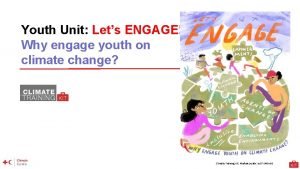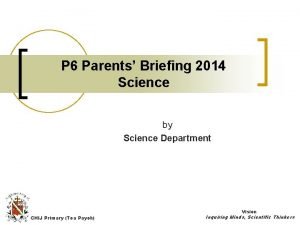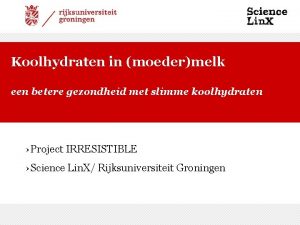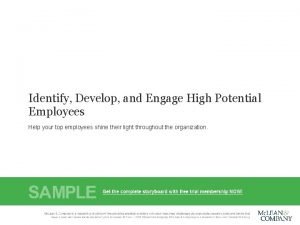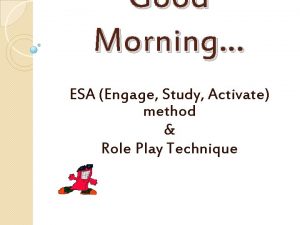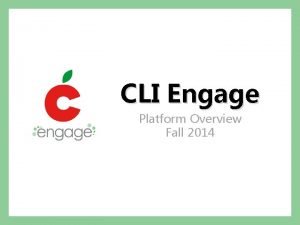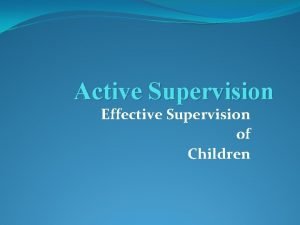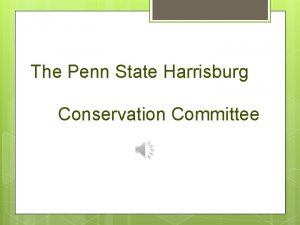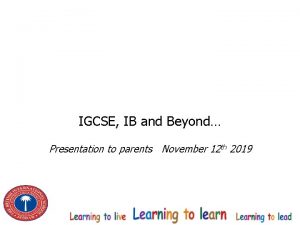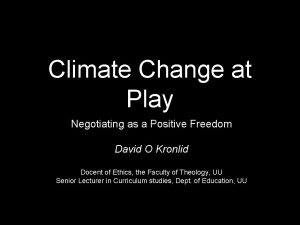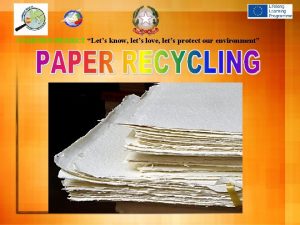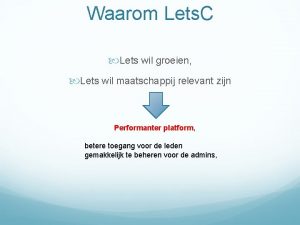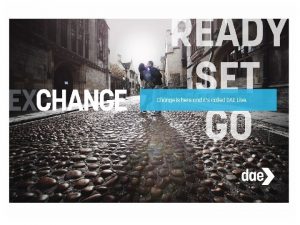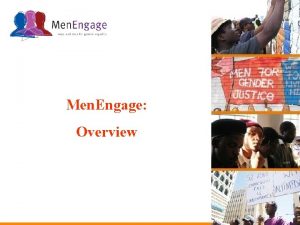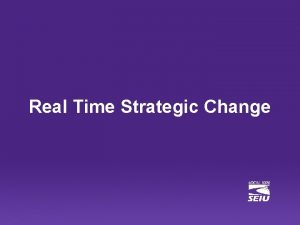Youth Unit Lets ENGAGE Why engage youth on




















- Slides: 20

Youth Unit: Let’s ENGAGE! Why engage youth on climate change? Climate Training Kit. Module youth: Let’s ENGAGE

Climate Training Kit. Module youth: Let’s ENGAGE

Overview 1. Climate change and youth 2. Youth as agents of change 3. Creating inclusive and enabling environments 4. Why engage the Red Cross Red Crescent Movement Climate Training Kit. Module youth: Let’s ENGAGE

1. Climate Change and Youth For the Red Cross Red Crescent Movement, the terms "youth" covers all people in the age range of 5 to 30 years. This includes: Children: age 5 -12 Adolescents: age 13 -17 Young adults: age 18 -30 % 1 n 4 o i , t 7 a l 1 u 0 p In 2 al po uth” ob f “yo l g e o h t d te of s i s con Climate Training Kit. Module youth: Let’s ENGAGE

1. Climate Change and Youth Why do / should youth care? Climate change is real and happening now! It is already increasing the number and severity of weather related disasters It will continue at an alarming rate unless humans drastically reduce greenhouse gas emissions Youth will have to deal with the consequences of decisions that are made now In 2019, an unprecedented number of youth protested to call for political action to address the climate crisis Climate Training Kit. Module youth: Let’s ENGAGE

1. Climate Change and Youth Why do / should youth care? Nearly 160 million children live in areas More than half a billion children live of high or extremely high drought in extremely high flood occurrence severity zones Climate Training Kit. Module youth: Let’s ENGAGE

1. Climate Change and Youth What do youth think? Young people around the world… Think climate change and the destruction of nature is the most critical issue. Over 90% of young people agree or strongly agree that Humans are responsible for climate change. Climate Training Kit. Module youth: Let’s ENGAGE

2. Youth as agents of change The world has evolved! Youth seen as: Victims Agents of Change h t u o y d e r e w o p m e & d e e g v l n o a v h n i c f o s t n Aware, e g a e v i t e c c e f n f a e v e d a o t can b s e i t i n u s m e i m g o e c t r a i r t e s n o in th i t a t p a d a e g n a h c e t a m i cl Climate Training Kit. Module youth: Let’s ENGAGE

2. Youth as agents of change Global map of school strikes 1. 5 million school students worldwide participated in school strikes for climate action in March 2019 (WEF, March 2019) Climate Training Kit. Module youth: Let’s ENGAGE

2. Youth as agents of change By engaging youth in an inclusive, gender-sensitive manner at local, national & international levels, we invest early in: • Opening mind-sets • Fostering dialogues • Encouraging platforms to reduce cross-sectoral barriers Inspiring youth-led action today, engages youth to advance collaborative climate change action going forward as tomorrows leaders Climate Training Kit. Module youth: Let’s ENGAGE

3. Creating inclusive and enabling environments – Why? • Climate change impacts can be different for boys & girls (see next slide) • Age, race, class and ability also shape how youth are impacted • During disasters, sometimes boys take on men’s roles & girls take on women’s roles • This can increase or decrease the amount boys or girls are at risk from the disaster Gender equity and inclusivity are key in creating enabling environments for effective and sustainable youth-led influence, advocacy & action v. See the ‘Gender Module’ for more information on gender & climate change Climate Training Kit. Module youth: Let’s ENGAGE

3. Creating inclusive and enabling environments – Why? Climate change impacts can be different for girls & boys(3) GIRLS BOYS Girls may be especially vulnerable during disasters, as they may be caring for siblings & becoming parents themselves, with less access to healthcare Boys are more likely to help search & rescue activities during disasters. This can have benefits but also exposes boys to additional risks Girls may have to miss school, during disasters that effect natural resources i. e. drought, as they have to walk further to collect water or firewood Some people expect boys to be strong and to look after themselves, which can have a negative impact on boys’ mental health Children who don’t think of themselves as a girl or a boy, may be at greater risk from social discrimination, abuse & sufficient shelter and health options during disasters. Climate Training Kit. Module youth: Let’s ENGAGE

3. Creating inclusive and enabling environments – How? • Place a conscious focus on inclusiveness in programs and projects. Think of: gender, age, race, class / caste / tribe, ability • Be aware of differentiated roles and responsibilities and how these may affect the vulnerability of all youth • Be aware of, and actively respond to, factors that increase the vulnerability for particular youth, such as violence and access to education • Recognise the abilities of all youth, not just their vulnerabilities Climate Training Kit. Module youth: Let’s ENGAGE

4. Why engage the Red Cross Red Crescent Movement - numbers About half of the volunteers of the International Red Cross and Red Crescent Movement are young people, which means around 7 million youth volunteers Climate Training Kit. Module youth: Let’s ENGAGE

4. Why engage the Red Cross Red Crescent Movement - mandate • Climate change is set to profoundly alter the way we live, and how we seek and share economic development (1) Previously: Climate change action referred to mitigation only: reducing greenhouse gases Now: Climate change action includes the need to adapt to climate change impacts, as well as mitigation • Climate Change Adaptation: a priority for the Red Cross Red Crescent Movement Climate Training Kit. Module youth: Let’s ENGAGE

4. Why engage the Red Cross Red Crescent Movement - policies The ‘IFRC’s Framework for Climate Action Towards 2020’ • Recognises the need to better engage and mobilise regional youth networks from a knowledge and understanding perspective • Recognises the importance of youth participation in National Societies and IFRC climate-smart community programming and policy frameworks The IFRC’s youth policy (2017) • Promotes youth as key drivers in humanitarian action & development • Youth can foster community resilience through meaningful engagement as today’s & tomorrow’s: Leaders Volunteers Members of affected communities Climate Training Kit. Module youth: Let’s ENGAGE

4. Why engage the Red Cross Red Crescent Movement - opportunities National Societies as auxiliary to government, have a strong position to cultivate youth advocacy to promote: • Meaningful participation • Youth-sensitive policies at local & national decision-making tables There is real opportunity to effectively & innovatively advance a crucially important youth-climate change agenda across the movement Climate Training Kit. Module youth: Let’s ENGAGE

4. Why engage the Red Cross Red Crescent Movement – Climate Centre Priorities Enabling Environments Empowerment Education • Promote strategic integration of inclusive youth engagement and climate change agendas • Support inclusive youth led action and advocacy on climate change, utilizing innovative approaches • Promote capacity building on climate change action and advocacy for youth and stakeholders Climate Training Kit. Module youth: Let’s ENGAGE

Vision of success • Youth across the world are more aware, engaged & able to act to adapt and make their communities more resilient to climate variability and weather extremes from a youth sensitive, inclusive outlook • Youth & their communities are better prepared for & resilient to climate change impacts • Climate change agendas at the international, national & local level promote youth engagement, in direct alignment to & in cooperation with youth agendas & partners at all levels • Gender sensitivity & inclusivity are core to all youth engagement activities and approaches Climate Training Kit. Module youth: Let’s ENGAGE

References • 1 IFRC Framework for Climate Action Towards 2020 • 2 United Nations Children’s Fund (UNICEF) (ed. ) (2014) The Challenges of Climate Change: Children on the front line. • UNICEF Office of Research – Innocenti 3 Shreve, C. and Fordham, M. (2018) Child-Centred Risk Reduction Research into Practice Brief: Gender and Disasters: Considering Children. Global Alliance for Disaster Risk Reduction & Resilience in the Education Sector Graphic accreditations • Rebeka Ryvola Photograph accreditations • Brigitte Rudram • Damon Coulter/Barcroft Images • Guatemala RCY • P Casier, CCAFs • Youth Engagement Strategy IFRC: https: //www. rcrc-resilience-southeastasia. org/document/ifrc-youth-engagement-strategy/ Image accreditations • The Noun Project • Y-Adapt images Climate Training Kit. Module youth: Let’s ENGAGE
 Lets engage
Lets engage Hey bye bye
Hey bye bye Dont ask why why why
Dont ask why why why Unit 6 review questions
Unit 6 review questions Engage explore explain elaborate evaluate
Engage explore explain elaborate evaluate Engage explore explain elaborate evaluate
Engage explore explain elaborate evaluate Engage
Engage High potential employee development best practices
High potential employee development best practices Engage study activate lesson plan example
Engage study activate lesson plan example Engage in excavation
Engage in excavation My wiggly amps
My wiggly amps Cli engage
Cli engage Principles of active supervision
Principles of active supervision Listening
Listening Engage new york kindergarten
Engage new york kindergarten Questioning and discussion techniques in the classroom
Questioning and discussion techniques in the classroom Psu harrisburg engage
Psu harrisburg engage Engage calgary
Engage calgary Bisj engage
Bisj engage Richard millwood
Richard millwood Ilinx engage
Ilinx engage
